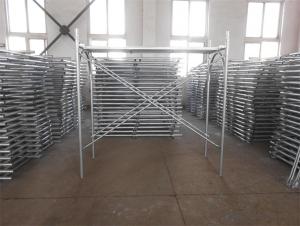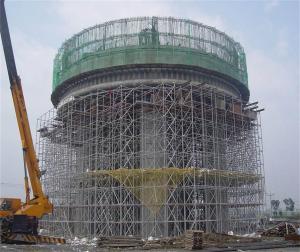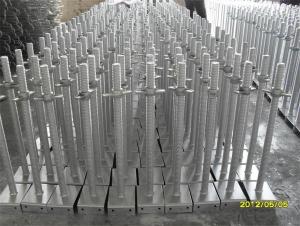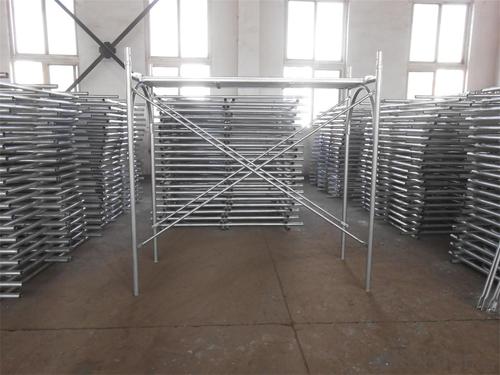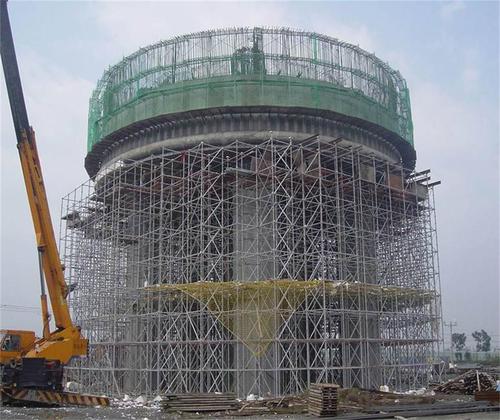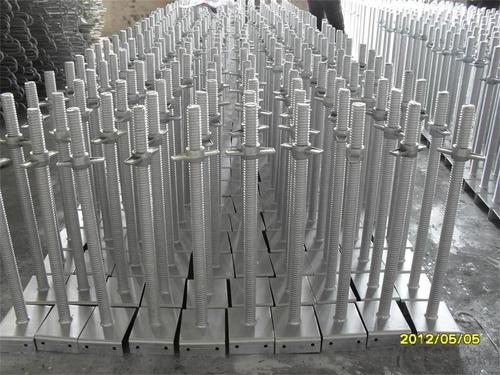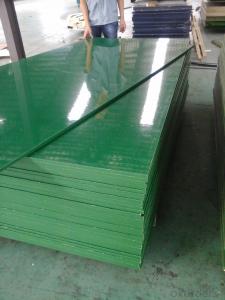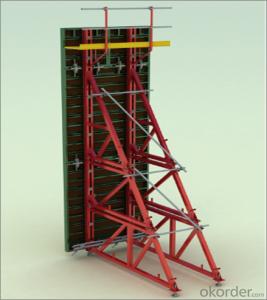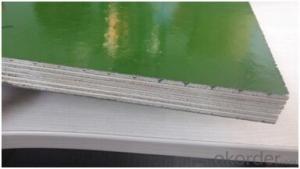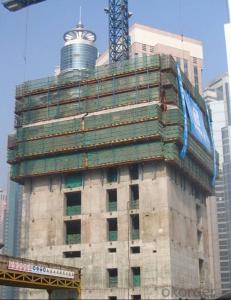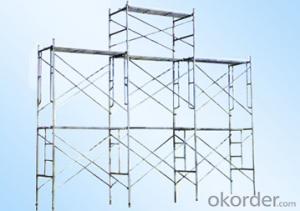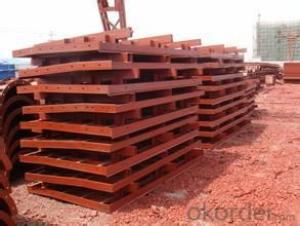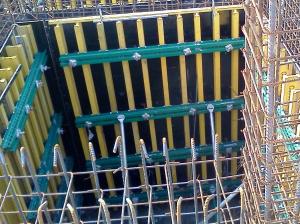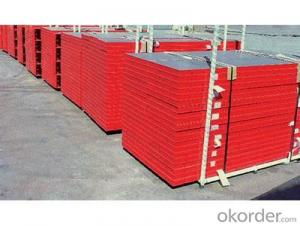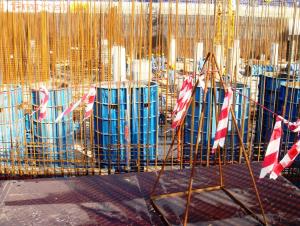Ring lock, Tower Scaffolding with Hot or Cold Galvanized Surface
- Loading Port:
- Shanghai
- Payment Terms:
- TT OR LC
- Min Order Qty:
- 1000 m²
- Supply Capability:
- 100000 m²/month
OKorder Service Pledge
OKorder Financial Service
You Might Also Like
1.Structure of Ring lock Description
Ringlock Scaffolding system is the most popular used Scaffolding system in the world.It will greatly reduce the cost because of the following advantages
Packaging & Delivery
Packaging Details:
Pallet or bag or upon client's request
Delivery Detail:
35days
2.Main Features of Ringlock
It will greatly reduce the cost because of the following advantages
1)Using less pipes
2)Easy to install
3)It can be used again and again for nearly 20years
3.Ring lock product pictures:
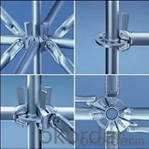
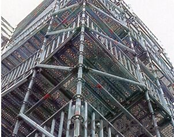
4.Ringlock Product Description
Type: ringlock scaffolding diagonal Brace
specification : Ø48.3×3.20
material:: steel Q235
Finished: Hot DIP galvanized, painted
Diagonal length(m) :Weight(kg)
0.9m * 1.25m 6.28
1.25m * 2.7m 11.45
5.FAQ
We have organized several common questions for our clients,may help you sincerely:
1)How about your company?
CNBM International Corporation, China National Building Materials (Group) Corporation, is one of the largest companies in China building material equipment industry, Our formwork and scaffolding are largely used in both domestic and all over world;
2)How many Scaffolding your company have?
Here comes our 5 types of Scaffolding systems:
- Cup lock Scaffolding(C-Lock Scaffolding)
- Ring lock Scaffolding
-Kwistage Scaffolding
-H-frame Scaffolding
-ID15 Scaffolding Tower, this type Scaffolding is the most widely used in construction, such like bridge.
3)How long can we receive the product after purchase?
Lead time is about 30days after getting the signed PI and deposit.
- Q: Can steel frame formwork be used for underwater concrete construction?
- Underwater concrete construction can utilize steel frame formwork as it offers various advantages. The durability, strength, and ability to withstand different environmental conditions make steel frame formwork a popular choice in construction projects. One advantage of steel frame formwork is its high resistance to corrosion, which is essential in underwater environments where the concrete is constantly exposed to water and moisture. The steel can endure the corrosive effects of saltwater and other chemicals found in the water, ensuring the long-lasting and structurally sound underwater concrete construction. Moreover, steel frame formwork provides exceptional stability and support, making it suitable for underwater applications. The rigid steel frames can withstand the water pressure and maintain the integrity of the formwork during the concrete pouring process. This stability is crucial in achieving the desired shape and dimensions of the underwater concrete structure. Additionally, the installation and removal of steel frame formwork are easy and efficient. The modular design of the formwork system allows for quick assembly and disassembly, which is convenient for underwater construction projects where time is often a critical factor. The flexibility of steel frame formwork also enables easy adjustments and modifications, ensuring precise concrete placement. In conclusion, steel frame formwork is an appropriate choice for underwater concrete construction due to its corrosion resistance, stability, and ease of installation. It provides a reliable and efficient solution for creating durable and strong underwater structures.
- Q: How does steel frame formwork prevent concrete leakage?
- There are several mechanisms in place that prevent concrete leakage when using steel frame formwork. To begin with, the steel frame establishes a solid structure that securely holds the formwork panels in position. This guarantees that there will be no movement or displacement of the panels during the pouring and curing of the concrete. Consequently, there will be no gaps or openings for the concrete to escape through. Furthermore, the steel formwork panels are designed to fit tightly and have seamless connections. This ensures that there are no visible joints or gaps between the panels, which could potentially allow the concrete to leak. Bolts or other mechanical fasteners are typically used to connect the panels, maintaining a strong and watertight seal. In addition, the steel formwork panels often undergo a coating or treatment process to enhance their water resistance. This can involve applying a layer of paint or a protective film to the surface of the panels. These coatings not only prevent concrete leakage but also protect the formwork from corrosion and other environmental factors, prolonging its lifespan. In conclusion, the combination of a rigid steel frame, secure panel connections, and protective coatings ensures that steel frame formwork effectively prevents concrete leakage. This is crucial for attaining high-quality concrete structures and avoiding any potential damage or failure caused by leakage.
- Q: What are the different types of connections used in steel frame formwork systems?
- There are two main types of connections used in steel frame formwork systems: bolted connections and welded connections. Bolted connections involve the use of nuts and bolts to secure the different components together, providing flexibility in assembly and disassembly. Welded connections, on the other hand, involve fusing the structural elements using heat, resulting in a permanent and strong connection. Both types of connections have their advantages and disadvantages depending on the specific requirements of the construction project.
- Q: How does steel frame formwork handle the placement of concrete in underwater or marine structures?
- Due to its durability and strength, steel frame formwork is frequently utilized in the construction of underwater or marine structures. When it comes to managing the concrete placement in such structures, steel frame formwork offers numerous advantages. First and foremost, steel frame formwork exhibits high resistance to water and corrosion. This makes it suitable for use in underwater or marine environments where the concrete is consistently exposed to water or saltwater. Unlike other materials, steel does not deteriorate or weaken when submerged in water for extended periods. Moreover, steel frame formwork provides exceptional stability and support during the concrete pouring process. The rigid structure of the steel frames ensures that the formwork remains intact and in place even under the pressure of the water. It can withstand the hydrostatic pressure exerted by the water and prevent any deformation or collapse of the formwork during the concrete placement. Furthermore, steel frame formwork allows for precise concrete shaping and positioning. The frames can be easily adjusted and secured in the desired position, guaranteeing accurate and uniform concrete pouring. This is especially crucial in underwater or marine structures where the concrete must be properly positioned to withstand the forces of the water. Additionally, steel frame formwork is reusable and can be easily disassembled and reassembled. This is advantageous in underwater or marine construction projects where the formwork needs to be repeatedly used. The ability to reuse the formwork saves time and costs in the long term. In conclusion, steel frame formwork is an ideal choice for managing the placement of concrete in underwater or marine structures. Its resistance to water and corrosion, stability, precise shaping capabilities, and reusability make it a dependable and efficient solution for construction in these challenging environments.
- Q: How does steel frame formwork handle different types of concrete admixtures?
- Steel frame formwork is a versatile and durable method for constructing concrete structures, and it can easily handle different types of concrete admixtures. Concrete admixtures are substances that are added to the concrete mix to enhance certain properties or characteristics of the final product. These admixtures can include accelerators, retarders, plasticizers, superplasticizers, air-entraining agents, and many others. Steel frame formwork provides a strong and rigid structure that can withstand the pressure and forces exerted by the concrete mix, regardless of the type of admixture used. The formwork system consists of steel panels, usually with plywood facing, that are connected together with strong and reliable locking mechanisms. This ensures that the formwork remains stable and secure during the pouring and curing process. When it comes to different types of concrete admixtures, steel frame formwork can easily accommodate them. For example, if an accelerator is added to the concrete mix to speed up the curing time, the steel frame formwork can handle the increased early strength development without any issues. Similarly, if a retarder is used to slow down the setting time, the formwork can provide the necessary support and stability during the extended curing period. Steel frame formwork is also compatible with plasticizers and superplasticizers, which are admixtures that improve the workability and flowability of the concrete mix. These admixtures increase the fluidity of the concrete, allowing it to easily flow and fill the formwork. The steel frame provides the necessary strength and rigidity to contain the highly fluid concrete mix and prevent any leakage or deformation. Furthermore, steel frame formwork can also handle air-entraining agents, which are admixtures that introduce tiny air bubbles into the concrete mix. These air bubbles improve the freeze-thaw resistance of the concrete and enhance its durability. The steel frame formwork ensures that the air-entrained concrete remains intact and properly consolidated during the pouring and curing process. In summary, steel frame formwork is well-equipped to handle different types of concrete admixtures. Its strength, stability, and compatibility with various admixtures make it a reliable choice for constructing concrete structures with enhanced properties and characteristics.
- Q: Can steel frame formwork be used for both low-rise and high-rise construction projects?
- Yes, steel frame formwork can be used for both low-rise and high-rise construction projects. Steel frame formwork is a versatile and durable option that can be easily adapted to different project requirements. It provides excellent stability and support, making it suitable for constructing buildings of various heights. Additionally, steel frame formwork allows for efficient and precise construction, ensuring the quality and accuracy of the finished structure. Whether it is a small low-rise building or a tall high-rise skyscraper, steel frame formwork can be used effectively to achieve the desired results.
- Q: How does steel frame formwork ensure proper alignment and leveling of the concrete structure?
- The concrete structure is aligned and leveled properly with the help of steel frame formwork, which is constructed to be sturdy and rigid. Precision is used in the design and manufacture of the steel frames to create a reliable framework for pouring concrete. To begin with, the steel frame formwork is assembled and firmly fixed in place before the concrete is poured. The frames are connected and secured together, creating a strong structure that can withstand the pressure and weight of the wet concrete. This ensures that there is no movement or shifting during the pouring and curing process, keeping the concrete in the desired position and form. Moreover, the steel frame formwork is designed with adjustable components to allow for easy and precise leveling. This ensures a perfectly flat and even surface for the concrete. The adjustable components, such as props, wedges, and screws, can be manipulated to raise or lower specific areas of the formwork as needed. This adaptability allows the formwork to accommodate any irregularities or variations in the ground or structure, guaranteeing that the concrete is poured evenly and accurately. In addition, the steel frame formwork provides a straight and true framework for the concrete structure. The frames are manufactured with high accuracy and dimensional stability, maintaining their shape and alignment throughout the construction process. This eliminates any potential for distortion or misalignment of the concrete structure, resulting in a finished product that is both structurally sound and visually pleasing. In conclusion, steel frame formwork ensures proper alignment and leveling of the concrete structure by providing a stable and rigid framework, adjustable components for precise leveling, and accurate dimensional stability. These qualities contribute to the successful construction of a concrete structure that is both structurally reliable and visually appealing.
- Q: Can steel frame formwork be used for both reinforced and non-reinforced concrete elements?
- Steel frame formwork is suitable for both reinforced and non-reinforced concrete elements. This type of formwork offers a sturdy and long-lasting structure that can handle the pressures exerted by fresh concrete while it is being poured and cured. Additionally, it is adaptable and can be effortlessly modified to fit various shapes and sizes of concrete elements. Whether it is used for reinforced concrete elements that necessitate extra reinforcement or non-reinforced concrete elements that rely solely on the concrete's strength, steel frame formwork can provide the essential stability and support for the efficient construction of both types of elements.
- Q: How does steel frame formwork contribute to the overall strength of a structure?
- Steel frame formwork contributes to the overall strength of a structure by providing a rigid and stable framework that supports the concrete during construction. This formwork system ensures accurate placement and alignment of the concrete, resulting in a strong and durable structure. The steel frame also helps to distribute the loads evenly, enhancing the structural integrity and load-carrying capacity of the building.
- Q: Can steel frame formwork be used for precast concrete cladding?
- Yes, steel frame formwork can be used for precast concrete cladding. Steel frame formwork is commonly used in the construction industry for its durability and strength. It provides a sturdy structure for pouring and shaping concrete, making it suitable for creating precast concrete cladding panels. The steel frame formwork ensures the desired shape and dimensions of the cladding are achieved, resulting in a high-quality finish.
Send your message to us
Ring lock, Tower Scaffolding with Hot or Cold Galvanized Surface
- Loading Port:
- Shanghai
- Payment Terms:
- TT OR LC
- Min Order Qty:
- 1000 m²
- Supply Capability:
- 100000 m²/month
OKorder Service Pledge
OKorder Financial Service
Similar products
Hot products
Hot Searches
